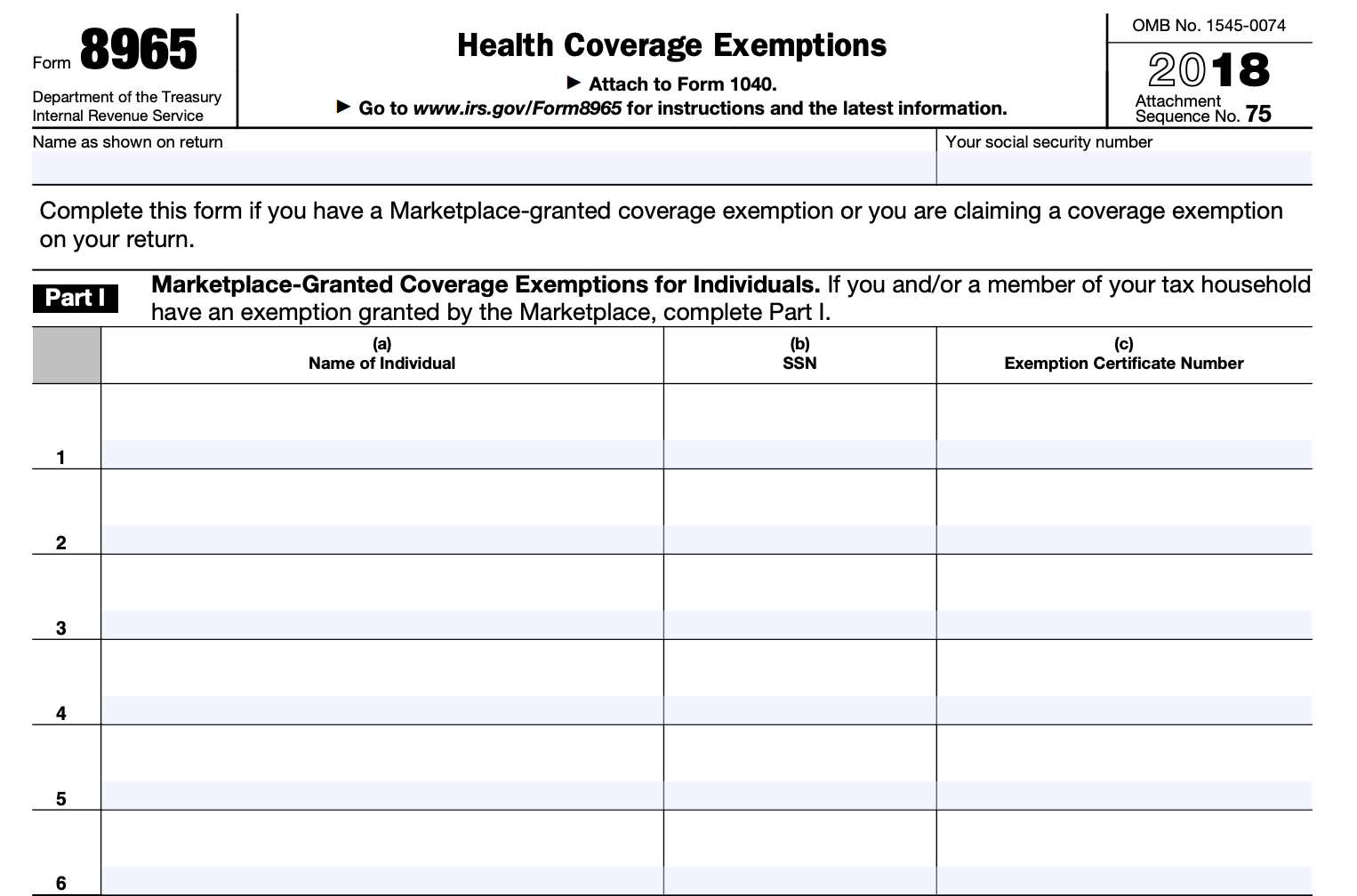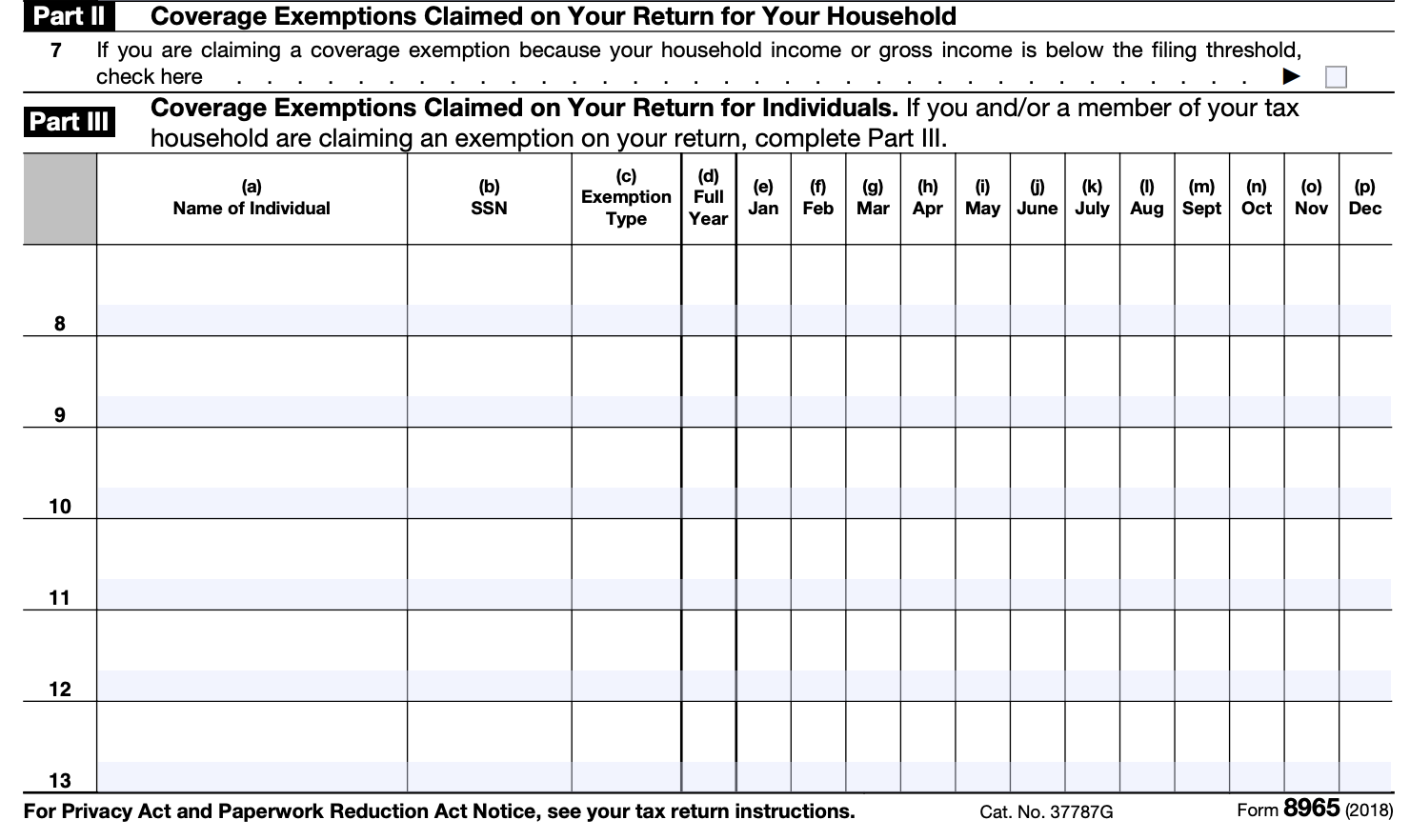If you’re claiming an exemption from healthcare coverage, you’ll need to fill out IRS form 8965 when you do your federal income taxes. This form helps you comply with Affordable Care Act rules that require health insurance coverage for just about everyone in the country. Here’s everything you need to know about the 8965 tax form and who’s qualified to use it. A financial advisor could help optimize your tax strategy for your financial needs and goals.
Who Needs Form 8965
You probably know that the passage of the Affordable Care Act ushered in an era when every American had to have “minimum essential coverage” or pay a penalty. Well, not exactly everyone. There are exemptions. But for each month of the tax year, you must either have health coverage, claim a coverage exemption or pay the penalty.
The exemptions let you opt out of the required health insurance coverage without having to pay a penalty when you file your taxes. This penalty is known as the shared responsibility payment. It’s important to understand what you have to do to earn one of these exemptions. “I forgot about the enrollment deadline” doesn’t count.
Health Coverage Exemptions
The full list of health coverage exemptions (with details for each exemption category) can be found on page 3 of the IRS instructions for form 8965. Here are some of the categories of exemptions that you can claim for a given tax year:
- Your income was below the tax filing threshold.
- You were living abroad for at least 330 days.
- You were a member of a healthcare-sharing ministry.
- You were incarcerated.
- You’re a member of a Native American Tribe.
- You were unable to renew your existing coverage.
- You can’t afford coverage.
- You live in a state that didn’t expand Medicaid and your income is less than 138% of the federal poverty line for your family size.
- You went without coverage for less than three consecutive months.
- A member of your household was born, died or adopted so you can’t check the box saying the whole household had 12 months of health insurance coverage.
- You’re a member of certain qualified religious sects.
- You were turned down for Medicaid in a state that didn’t expand Medicaid.
- You experienced “general hardship.”
- You participated in one of certain Medicaid programs that aren’t considered minimum essential coverage.
How to Fill Out Form 8965
So you qualify for one of the above exemptions? Now you have to document that fact on form 8965. First, write your name and Social Security Number at the top of the form. From there, you’ll need to decide whether you should fill out Part I, II or III of the form.

If you or a member of your household is claiming a Marketplace-granted exemption, write each exemption-claiming person’s name, Social Security number and exemption certificate number in Part I of the form.
What’s a Marketplace-granted exemption and what’s an exemption certificate number? Great questions. Some exemptions from the minimum essential coverage requirement can simply be claimed on the 8965 form when you file your taxes.
However, other exemptions need to be applied for in advance and granted by the Health Insurance Marketplace, which will then send you an exemption certificate number if your application is granted. The exemptions that require an advance application through the Marketplace and need an exemption certificate number are the exemptions for:
- General hardship
- Certain religious sect members
- Not being able to afford coverage
- Being ineligible for Medicaid in a state that did not expand Medicaid coverage
- Being unable to renew existing coverage
- Having AmeriCorps coverage
This IRS chart shows which exemptions can only be granted by the Marketplace, which can be granted by the Marketplace or claimed on your tax return and which exemptions may only be claimed on your tax return.
If you or a household member have a Marketplace-granted exemption, enter them in Part I of the 8965 form by writing the name of the exempt household member, his/her Social Security number and the exemption certificate number received from the Marketplace. If your Marketplace exemption application is still pending, write “pending” in Section C) under “Exemption Certificate Number.”
If you or a member of your household is claiming an exemption that’s not Marketplace-granted, move on to Part II or Part III, depending on your situation.

Part II of Form 8965 is for those whose income is below the filing threshold. If your income is low enough that you do not need to file taxes, you don’t need to file form 8965 to prove exemptions and you will automatically be exempt from the penalty, a.k.a. the shared responsibility payment. But you may still decide you want to file taxes to, say, get access to tax credits. If that’s the case, check whichever of the two boxes in Part II applies to your income situation.
If neither Part I nor Part II applies to you, move on to Part III. This is where you can enter exemptions that aren’t Marketplace-granted and aren’t based on your income below the filing threshold. The exemptions eligible for Part III include those for short coverage gaps and those who were living abroad. The full list of exemptions minus those that can only be granted by the Marketplace can be claimed in this section.
Consult the “Types of Coverage Exemptions” chart in the IRS Form 8965 instructions to find out the name of the exemption you’re claiming and get the letter code that you’ll need to enter in Part III of Form 8965. For example, if you’re claiming the exemption for having a short coverage gap, you’ll enter the letter “B” in the “Exemption Type” column in Part III of Form 8965.
For each member of the household claiming a Part III exemption, you’ll write the name, Social Security number, exemption type and exemption period. You can check the box for “full-year” or for any combination of the 12 months of the year. So, if you had a one-month coverage gap in July between jobs, you would write your name and Social Security number. You’d write “B” under “Exemption Type” and tick the box for the month that you went without coverage, July.
Bottom Line

If you and the other members of your household had health insurance coverage for the full year, there’s no need to worry about Form 8965. But if you’re eligible for exemptions (the IRS offers a tool to help you determine if you’re eligible for an exemption), it’s important to take the time to fill out form 8965 carefully. Otherwise, you’ll need to pay the penalty. Once you’ve determined that you need form 8965 and you’ve filled it out correctly, you can attach it to your form 1040, 1040A or 1040EZ.
Tips for Navigating Tax Season
- A financial advisor can be a key resource in helping you figure out your taxes. Finding a financial advisor doesn’t have to be hard. SmartAsset’s free tool matches you with up to three vetted financial advisors who serve your area, and you can have a free introductory call with your advisor matches to decide which one you feel is right for you. If you’re ready to find an advisor who can help you achieve your financial goals, get started now.
- If you don’t know whether you’re better off with the standard deduction versus itemized, you might want to read up on it and do some math. Educating yourself before the tax return deadline could save you a significant amount of money.
- SmartAsset has you covered with several free online tax resources to help you during tax season. Check out our income tax calculator and get started today.
Photo credit: ©iStock.com/marekuliasz, Images of Form 8965 from IRS.gov, ©iStock.com/sturti